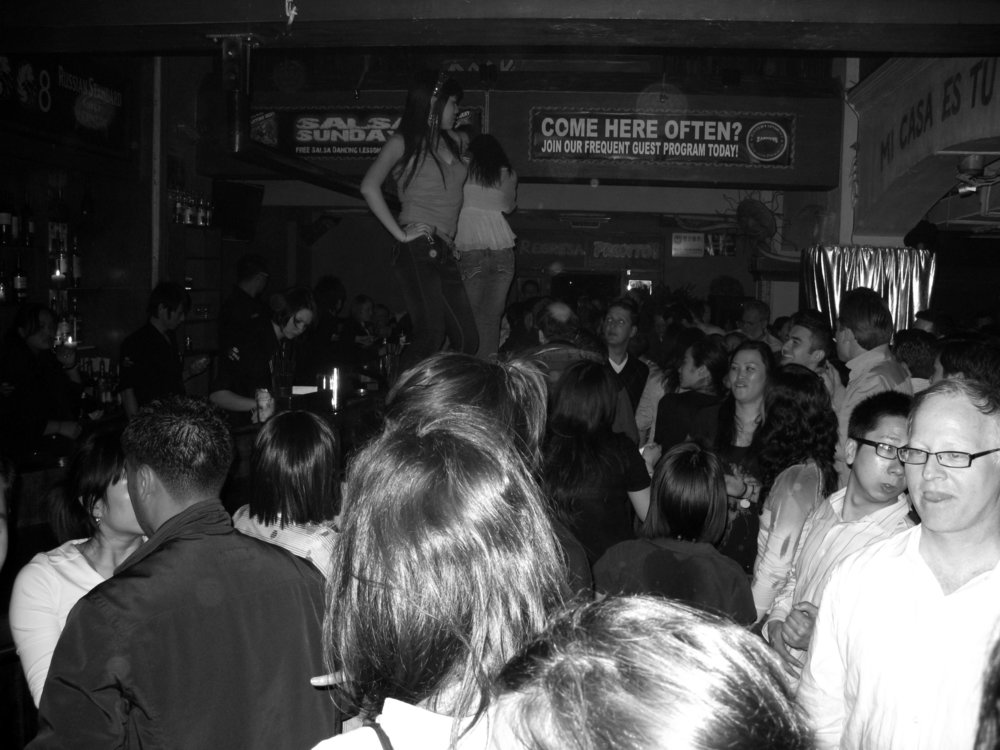
(I shot this photo at Zapatas in 2008--James is on the far right)
Over the next few months, as we gear it up for publication with U Chicago Press later, I'll be making some more announcements about my upcoming book, Shanghai Nightscapes, co-authored with James Farrer. This book uses the methods of the historian, sociologist, and ethnographer to trace a century of Shanghai's history through the lens of its nightlife, with a focus on establishments featuring dancing and/or drinking in a public social environment as their main activities. Here is a section of our working manuscript discussing how we wrote the book:
Writing this Book
This book is based on our twenty years of intermittent fieldwork and writing in and about Shanghai, which began for both of us in the 1990s as dissertation research resulting in each author’s first book.[i] In between, we have organized conferences related to this project, published articles, some of which are the bases of chapters here, produced documentary films, and even led tours of Shanghai nightlife.[ii] In the year 2000 we began serious discussion on the new project to connect history with sociology and a narrative of Republican Era nightlife with the nightlife emerging after 1980, using materials we have not published before, and an entire new body of ethnographic fieldwork beginning in 2001.
Our methodology is a combination of historiographic and ethnographic methods using multiple data sets generated over these two decades. We use Chinese, English and some Japanese texts, including newspapers, magazines, novels, archival records, and websites, depending on the period we are describing. We used our Chinese and English (and occasionally Japanese) language skills to interview dozens of key players in the city’s nightlife industry, including club and bar managers, owners, musicians, DJs, staff, hostesses, and other workers. In addition, we also conducted informal conversations and lengthy face-to-face interviews with a wide range of nightlife patrons, who varied in terms of their national and regional origins, ages, gender, tastes, income levels, and sexual orientations.[iii] Over many more than a thousand nights out from 1993 to 2014, we visited nightlife establishments located throughout the city, and took notes regarding their designs, décor, music, social compositions and interactions. Key informants – male, female, Chinese, non-Chinese, straight and gay –guided our visits, filled in the gaps in our research and pointed out our blind spots.[iv] For each of the contemporary venues that are described at length in the book we did all these things, visiting them at least a dozen times (in some cases becoming regulars over several years), while interviewing key players and patrons. Many of these people are our friends. Indeed, the two authors met each other for the first time in a bar in Shanghai in 1996 (the Hit House bar featured in Chapter 5), and now after twenty years of intermittent fieldwork and writing, we hope this book is a fitting tribute to Shanghai’s urban nightscapes and all the friendships that began there.
[i] Field Shanghai’s Dancing World; James Farrer, Opening Up: Youth sex culture and market reform in Shanghai (Chicago: University of Chicago Press, 2002).
[ii] The journal special issue that emerged out of a conference at Sophia University, see China – An International Journal 6(1) (March 2008). Andrew Field and Jud Willmont produced and directed an independent documentary film, Down: Indie Rock in the PRC, focusing on the Chinese indie rock scene. See www.chinarockdoc.com for details about this documentary film. Field also produced a short film about Shanghai’s jazz and blues scenes that has not yet been released, and he still occasionally gives tours of Shanghai’s historic nightlife districts.
[iii] The interview excerpts in this book are from interviews conducted by Farrer or Field, and in a few cases by a research assistant. For public figures such as bar owners, we use real names. For regular patrons, we use only pseudonyms. Pseudonyms are indicated by quotes in the text or the footnotes. In most cases interviews were recorded and transcribed by assistants, or in the case of ethnographic field interviews, were written up by the interviewers directly after the conversation. Given that this book combines interviews from many different studies, it is impossible to account the number of informants for this book but it would be in the hundreds.
[iv] We realize that for some readers this assurance of multiple viewpoints provided by key informants is not enough. Some might question if two white, “straight” American men can interview Chinese women, gay Chinese men, even if they have the language skills and years of local knowledge that we have. Frankly, we do not share this view, but rather strongly believe in the possibilities of intersubjective recognition and understanding across the boundaries of presumed gender, racial, national, and sexual difference. The alternative is a solipsistic view of research in which we can only study someone virtually identical to ourselves. For a view similar to ours see Robert Weiss, Learning From Strangers: The Art and Method of Qualitative Research Studies (New York: Free Press, 1995). Weiss is also our primary guidebook to the art of individual in-depth interviewing.